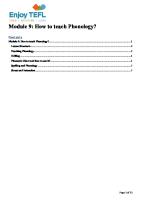PHONOLOGY [PDF]
PHONOLOGY Phonology is essentially the description of the systems and patterns of speech sounds in a language. It is, in
31 0 381KB
Papiere empfehlen
![PHONOLOGY [PDF]](https://vdoc.tips/img/200x200/phonology.jpg)
- Author / Uploaded
- Ramanakumar Mohan
Datei wird geladen, bitte warten...
Zitiervorschau
PHONOLOGY Phonology is essentially the description of the systems and patterns of speech sounds in a language. It is, in effect, based on a theory of what every speaker of a language unconsciously knows about the sound patterns of that language. Because of this theoretical status, phonology is concerned with the abstract or mental aspect of the sounds in language rather than with the actual physical articulation of speech sounds. Phonology is about the underlying design, the blueprint of each sound type, which serves as the constant basis of all the variations in different physical articulations of that sound type in different contexts. When we think of the [t] sound in the words tar, star, writer and eighth as being ‘the same’, we actually mean that, in the phonology of English, they would be represented in the same way. In actual speech, these [t] sounds are all very different. However, all these articulation differences in [t] sounds are less important to us than the distinction between the [t] sounds in general and the [k] sounds, or the [f] sounds, or the [b] sounds, because there are meaningful consequences related to the use of one rather than the others. These sounds must be distinct meaningful sounds, regardless of which individual vocal tract is being used to pronounce them, because they are what make the words tar, car, far and bar meaningfully distinct.
Phonemes Each one of these meaning-distinguishing sounds in a language is described as a phoneme. When we considered the basis of alphabetic writing in chapter 3, we were actually working with the concept of the phoneme as the single sound type which came to be represented by a single written symbol. It is in this sense that the phoneme /t/ is described as a sound type, of which all the different spoken versions of [t] are tokens. Note that slash marks are conventionally used to indicate a phoneme, /t/, an abstract segment, as opposed to the square brackets, as in [t], used for each phonetic or physically produced segment. The technical terms used in creating those charts can be considered ‘features’ that distinguish each phoneme from the next. If the feature is present, we mark it with a plus sign (+) and if it’s not present, we use a minus sign (− ). Thus /p/ can be characterized as [− voice, +bilabial, +stop] and /k/ as [− voice, +velar, +stop). Because these two sounds share some features, they are sometimes described as members of a natural class of sounds. The prediction would be that sounds which have features in common would behave phonologically in some similar ways. A sound which does not share those features would be expected to behave differently. For example, /v/ has the features [+voice, +labiodental, +fricative] and so cannot be in the same ‘natural’ class of sounds as /p/ and /k/. Although other factors will be involved, this feature analysis could lead us to suspect that there may be a good phonological reason why words beginning with / pl-/ and /kl-/ are common in English, but words beginning with /vl-/ are not.
Phones and allophones
While the phoneme is the abstract unit or sound type (‘in the mind’), there are many different versions of that sound type regularly produced in actual speech (‘in the mouth’).We can describe those different versions as phones. Phones are phonetic units and appear in square brackets. When we have a group of several phones, all of which are versions of one phoneme, we add the prefix ‘allo-’ (=one of a closely related set) and refer to them as allophones of that phoneme. For example, the [t] sound in the word tar is normally pronounced with a stronger puff of air than is present in the [ t] sound in the word star. If you put the back of your hand in front of your mouth as you say tar, then star, you should be able to feel some physical evidence of aspiration (the puff of air) accompanying the [t] sound at the beginning of tar (but not in star). This aspirated version is represented more precisely as [ th]. That’s one phone. In the last chapter, we noted that the [t] sound between vowels in a word like writer often becomes a flap, which we can represent as [D]. That’s another phone. In the pronunciation of a word like eighth (/etθ/), the influence of the final dental [θ] sound causes a dental articulation of the [t] sound. This can be represented more precisely as [t_]. That’s yet another phone. There are even more variations of this sound which, like [th], [D], and [t_], can be represented in a more precise way in a detailed, or narrow phonetic transcription. Because these variations are all part of one set of phones, they are typically referred to as allophones of the phoneme /t/. The crucial distinction between phonemes and allophones is that substituting one phoneme for another will result in a word with a different meaning (as well as a different pronunciation), but substituting allophones only results in a different (and perhaps unusual) pronunciation of the same word.
Minimal pairs and sets Phonemic distinctions in a language can be tested via pairs and sets of words. When two words such as pat and bat are identical in form except for a contrast in one phoneme, occurring in the same position, the two words are described as a minimal pair. More accurately, they would be classified as a minimal pair in the phonology of English. (Arabic, for example, does not have this contrast between /p/ and /b/.) Other examples of English minimal pairs are fan–van, bet–bat, site–side. Such pairs have traditionally been used in the teaching and testing of English as a second or foreign language to help students develop the ability to understand the contrast in meaning based on the minimal sound contrast. When a group of words can be differentiated, each one from the others, by changing one phoneme (always in the same position in the word), then we have a minimal set. For example, one minimal set based on the vowel phonemes of English could include feat, fit, fat, fate, fought, foot, and another minimal set based on consonant phonemes could have big, pig, rig, fig, dig, wig. Phonotactics This type of exercise involving minimal sets also allows us to see that there are definite patterns in the types of sound combinations permitted in a language. In English, the minimal set we have just listed does not include forms such as lig or vig. According to the dictionary, these are not English words, but they could be viewed as possible English words. That is, our phonological knowledge of the pattern of sounds in English words would allow us to treat these forms as acceptable if, at some future time, they came into use. They might,
for example, begin as invented abbreviations (I think Bubba is one very ignorant guy.∼Yeah, he’s a big vig). Until then, they represent ‘accidental’ gaps in the vocabulary of English. It is, however, no accident that forms such as [fs g] or [rn g] do not exist or are unlikely ever to exist. They have been formed without obeying some constraints on the sequence or position of English phonemes. Such constraints are called the phonotactics (i.e. permitted arrangements of sounds) in a language and are obviously part of every speaker’s phonological knowledge. Because these constraints operate on a unit that is larger than the single segment or phoneme, we have to move on to a consideration of the basic structure of that larger phonological unit called the syllable.









